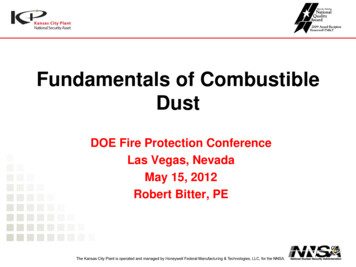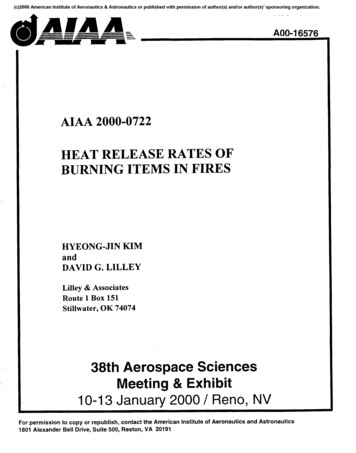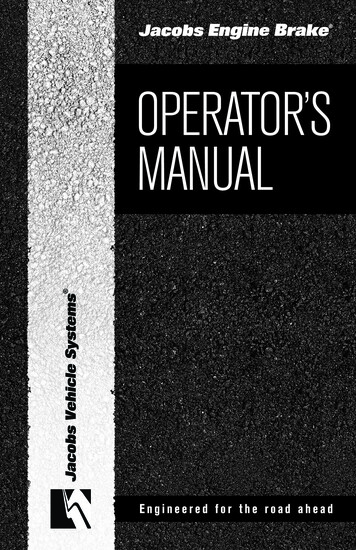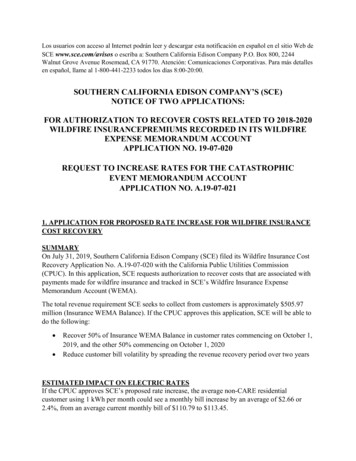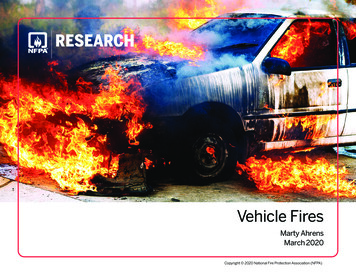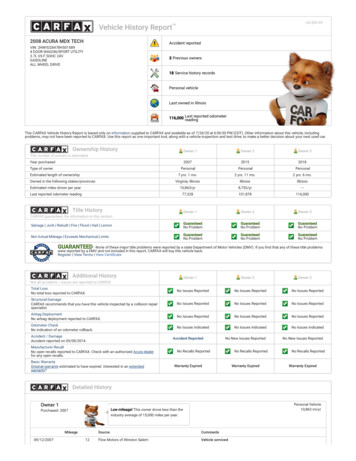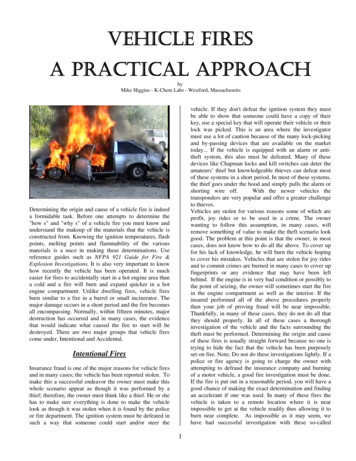
Transcription
VEHICLE FIRESA PRACTICAL APPROACHbyMike Higgins - K-Chem Labs - Westford, Massachusettsvehicle. If they don't defeat the ignition system they mustbe able to show that someone could have a copy of theirkey, use a special key that will operate their vehicle or theirlock was picked. This is an area where the investigatormust use a lot of caution because of the many lock-pickingand by-passing devices that are available on the markettoday. If the vehicle is equipped with an alarm or antitheft system, this also must be defeated. Many of thesedevices like Chapman locks and kill switches can deter theamateurs’ thief but knowledgeable thieves can defeat mostof these systems in a short period. In most of these systems,the thief goes under the hood and simply pulls the alarm orshorting wire off.With the newer vehicles thetransponders are very popular and offer a greater challengeto thieves.Vehicles are stolen for various reasons some of which areprofit, joy rides or to be used in a crime. The ownerwanting to follow this assumption, in many cases, willremove something of value to make the theft scenario lookgood. The problem at this point is that the owner, in mostcases, does not know how to do all the above. To cover upfor his lack of knowledge, he will burn the vehicle hopingto cover his mistakes. Vehicles that are stolen for joy ridesand to commit crimes are burned in many cases to cover upfingerprints or any evidence that may have been leftbehind. If the engine is in very bad condition or possibly tothe point of seizing, the owner will sometimes start the firein the engine compartment as well as the interior. If theinsured performed all of the above procedures properlythen your job of proving fraud will be near impossible.Thankfully, in many of these cases, they do not do all thatthey should properly. In all of these cases a thoroughinvestigation of the vehicle and the facts surrounding thetheft must be performed. Determining the origin and causeof these fires is usually straight forward because no one istrying to hide the fact that the vehicle has been purposelyset on fire. Note; Do not do these investigations lightly. If apolice or fire agency is going to charge the owner withattempting to defraud the insurance company and burningof a motor vehicle, a good fire investigation must be done.If the fire is put out in a reasonable period, you will have agood chance of making the exact determination and findingan accelerant if one was used. In many of these fires thevehicle is taken to a remote location where it is nearimpossible to get at the vehicle readily thus allowing it toburn near complete. As impossible as it may seem, wehave had successful investigation with these so-calledDetermining the origin and cause of a vehicle fire is indeeda formidable task. Before one attempts to determine the"how s" and "why s" of a vehicle fire you must know andunderstand the makeup of the materials that the vehicle isconstructed from. Knowing the ignition temperatures, flashpoints, melting points and flammability of the variousmaterials is a must in making these determinations. Usereference guides such as NFPA 921 Guide for Fire &Explosion Investigations. It is also very important to knowhow recently the vehicle has been operated. It is mucheasier for fires to accidentally start in a hot engine area thana cold and a fire will burn and expand quicker in a hotengine compartment. Unlike dwelling fires, vehicle firesburn similar to a fire in a barrel or small incinerator. Themajor damage occurs in a short period and the fire becomesall encompassing. Normally, within fifteen minutes, majordestruction has occurred and in many cases, the evidencethat would indicate what caused the fire to start will bedestroyed. There are two major groups that vehicle firescome under, Intentional and Accidental.Intentional FiresInsurance fraud is one of the major reasons for vehicle firesand in many cases; the vehicle has been reported stolen. Tomake this a successful endeavor the owner must make thiswhole scenario appear as though it was performed by athief; therefore, the owner must think like a thief. He or shehas to make sure everything is done to make the vehiclelook as though it was stolen when it is found by the policeor fire department. The ignition system must be defeated insuch a way that someone could start and/or steer the1
"Crispy Critters". In the debris, we have found keys andother items that indicate the vehicle was not stolen.In some inexpensive or older vehicles, the population ofcomponents in the engine is sparse and there is less plasticused. In these vehicles fire does not spread as rapidlytherefore burns for a longer period or it has a better chanceof burning itself out. The origin of the fire in the engine issometime quite difficult because of the amount offlammable items and how easy the fire transmits betweenthem. For example, assume that an electrical wire in aharness shorted in such a way that it became very hot. Thiswould cause the vinyl coating on the wire, and thosesurrounding it, to melt and then ignite. The harness willnow act like a wick carrying the fire to a location whereother flammable items are, thus causing them to ignite.Now assume the secondary fire burns very intense beforethe fire is put out. For example: If the fire burns in the areaof the master cylinder or hydraulic lines in heavyequipment, the fluid will ignite resulting in an intense areaof burning. The appearance of this second burn will make itlook like the origin. This will also mislead investigators tothinking that the short was caused by second fire. Like inmost fires, the greatest area of burning is not necessarily thearea of origin. What came first, the chicken or the egg?This is a common dilemma in vehicle fire determination.Other types of intentional fires are; revenge, to cover up acrime and destroy evidence.Investigating a revenge fire is difficult because no oneseems to know the reason why or motive the vehicle wasburned unless a message of some type was conveyed to thevictim. In many cases, these fires are left undetermined ifthey are burned out, credited to vandalism or are veryobvious due to the hurried manner the fire was set. Thesefires occur in the vicinity of where the victim works orlives. Rarely will you see a vehicle stolen for the purpose ofrevenge. This would expose the perpetrator to his greatestfear, which is of being caught.Fires to cover up a crime or destroy evidence are notalways obvious because you are dealing with professionalthieves that know how to steal vehicles. In many cases,these vehicles are fairly new and fast. These vehicles willbe found with various levels of ignition damage andnothing will be stolen from them. If the insurance companyor police agency investigator does not know that the vehiclewas stolen for use in a crime, they may suspect that theowner is involved because nothing was stolen from thevehicle. This is where proper investigative techniques mustbe used to avoid accusing an innocent person of a crime ordenying their insurance claim.Improperly factory installed battery cable on the solenoid caused fivenew vehicles to burn.Accidental FiresThis is where your knowledge of the particular vehicle isvery important. Before attempting to examine the vehicle,check on line to the various consumer and governmentagencies to see if there are recalls or historical data to assistyou. The majority of accidental fires occur in the enginecompartment. This is true for automobiles, trucks andheavy equipment. Prior knowledge of how the componentsare laid out and how dense their arrangement is will helpyou to understand how rapid the fire spreads. The enginecompartments of modern vehicles have many plasticcomponents that once ignited will quickly spread the fire.Fire along the door of this vehicle was caused by poor workmanshipwhile installing a 12volt line to a lantern chargerVehicle fires are caused by defective or worn components,poor workmanship, age or normal deterioration and lack2
of proper maintenance. Before attempting to examine aburned vehicle, find out its history. When was the last timethe vehicle was driven? How well did it run? When is thelast time the vehicle was serviced? Have there been anyproduct recalls on this vehicle?This personal bus stated burning at rear left side while drivingWire were installed under metal trim and hold-down screw penetratedwire insulation causing short to groundIt has been estimated that modern vehicles containhundreds of pounds of plastic materials (approximately 250- 350 lbs, depending on size). The majority of these plastics melting temperatures are approximately340o F and above. It is not until these plastics begin to meltare the fire retardants driven out and at this point, thematerial becomes virgin plastic and will burn rapidly.Poor maintenance failed to properly tighten engine pipe exhaust clampwas the causeWith the new hybrid or all electric vehicles the majority ofthese are constructed with plastic or fiberglass and willburn very complete leaving little to no evidence as to causeor origin. Finding many wires that short as a result of thefire is very common. In these fires it is very important toget as much information as possible before investigating.Antifreeze FiresThese are probably the most common among olderautomobile engine fires. Many car and trucks today areinvolved in fires that are caused by antifreeze leaking on tohot engine surfaces. Many of these fires are goingcompletely unsolved because many investigators do notrealize how flammable antifreeze is.Many times you will hear the scenario that someone wasdriving along and noticed the engine was overheating orsaw steam coming from the engine compartment and whenthey stopped the engine burst on fire. What happenedhere? Antifreeze is a mixture of ethylene glycol and waterat a normal dilution of 50/50. Ethylene glycol has a flashpoint of 231.8o F and the auto-ignition temperature is 770oF and the LEL 3.2% UEL 15.3% We also know that themanifold in a running gasoline engine or turbo charger intrucks can reach temperatures that well exceed theAutoignition temperatureof ethylene glycol. Thesetemperatures can auto-ignite even the heaviesthydrocarbons found in the engine compartmentWhen hot antifreeze mix leaks onto the hot surfaces of anengine, the water/glycol will begin to boil, keeping thesolvent mix at a temperature of approximately 225o F untilmost of the water has boiled away. (Mixing antifreeze towater raises its boiling point) At this point, what remains ispure ethylene glycol that will now heat and vaporize to itsflash point of 240.8oF. If a stray spark from a high voltagePolyurethane FoamThis is standard material throughout the interior of themodern vehicle. It is contained within the seat cushions,dashboard, headliner, door panels, consoles and armrest.This material will burn with the intensity of gasoline onceignited. I have demonstrated the intensity of a fire fueledonly by the plastic and polyurethane foam at many carburning demonstrations by simply starting a small firebehind the dash using a hand full of newspaper. This willhave the interior engulfed in flames within five minutes andit does not make much difference if I left the windows openor closed. Even with windows closed in today's vehiclethere is ample air coming through the vents that will feed aslow growing fire. The temperature difference between theinside and outside, in most cases, will quickly causewindows to fracture and break allowing in more air oroxygen. Polyurethane foam burns like any liquid accelerantwhere the hydrocarbons must be driven into a gaseous state(vapor) before they will burn.3
wire or an electrical component occurs in the area of thevapors from the glycol, ignition will occur. If no spark isavailable, then the glycol will continue to heat andvaporize. If a portion of the glycol comes in contact with ahot manifold or turbo charger surface, then auto-ignitionwill occur. Once ignition occurs in either of the abovecases, the fire will burn in a normal manner and ignite otherpetroleum products or plastics in the engine.Thisphenomenon has been reproduced and documented manytimes at K-Chem Labs. These experimental results havebeen used in courtrooms to prove beyond a doubt themanner in which antifreeze fires occur. Being a petroleumproduct, ethylene glycol or propylene glycol burn veryintense and will reach temperatures in excess of 1300o F.These temperatures are sufficient to cause the melting ofaluminum and zinc engine components such as radiators,alternator housings, air conditioning pumps, valve coversand carburetors.These accidental fires will sometimes have the appearanceof being intentional because of the heat that is generated orthe appearance of accelerant burn patterns. It is normal foraluminum radiators to burn or melt from the top down in a"V" pattern. This happens as the antifreeze boils out andburns causing the radiator to melt. In cold engines, contraryto the above, rarely will you ever see an accidental fire as adirect result of antifreeze. This is why it is very importantfor a fire investigator to have complete knowledge of all theevents related to the vehicle before the fire started.still return a pulse to the pump. This little fuel leak cancause a fire to start if a spark or very hot surface comes incontact with fuel or vapors. The listed auto-ignitiontemperature of gasoline is 810o F. This temperature resultis done at the lab in a closed cup Pensky-Martens apparatusand using an ASTM standard procedure. This test does notsimulate the conditions in a vehicle. It has been estimatedthat, it takes temperatures in access of 1700o F to autoignite gasoline vapors in the vehicle atmosphere. Do not bemislead by these values, where the flash point of gasoline isanywhere between -45o to -25 o F, a simple electricalspark, which has a temperature greater than 3500o F, willignite the gasoline vapors instantly.Fires that start in the area of the carburetor and burn for anextended period will sometimes cause melting of thecarburetor as long as a continual supply of fuel is available.The area under the carburetor in general does not have a lotof flammable products, so there has to be a supply of fuel tocause the heating of the carburetor to its melting point. (900o -1220o F ) This also causes the burning of the painton the hood directly above it. The hood is a great indicatorof the location and intensity of the fire in the engine.Breaks or bad connections in metal fuel line are, in manycases, easy to find. With so many vehicle now using plasticlines, finding a fuel leak cause becomes near impossiblebecause all the lines burn away.Improperly installed fuel injector destroyed this vehicleGasoline FiresThese happen because of various faults in the fuel lineconnections, carburetor or fuel injection systems. It isbecoming more common today to see the electric fuel pumplocated in or at the gas tank. The great safety feature builtinto most of these pumps is that they must receive a returnpressure pulse from the return fuel line in order to produceanother pulse of fuel. If the feed or return fuel linedevelops a large fuel leak such that no return pulse gets tothe pump, then the system immediately shuts down. Thebenefit of this is if the fuel line breaks open, only a littlefuel will escape. If a fire is generated by this break, noadditional fuel will feed the fire. These systems are not atotal cure though because the fuel lines can leak a little and4
The above vehicle was totally destroyed as a result of a the defective autoshutoff filler valve causing diesel to over fill the tank and the vehicle leftrunning while being fueledA cracked oil feed line to turbo was the causeElectrical FiresDiesel Engine FiresMuch of what I said earlier applies here even though theytend to run cooler than gasoline engines. Turbo chargersfailure or leaks can cause fires. A turbo surface can reachtemperatures in excess of 900o F while the engine is underload.Oil FiresThese happen as a result of carelessness, oil leaking fromvalve covers or leaking lines that migrates to the hotmanifold surface. Oil will auto-ignite at 850o F. These arenot uncommon fires. There have been factory recalls thataddressed this problem by placing diverters to keep leakingoil from flowing onto the manifold. In many cases, thesefires will be misread thinking they are caused by a fuelleak. This is because the fire burns up the side of the enginecausing damage to the carburetor or area about it.Fire started in front of the vehicle after it was turned offPower steering and Brake fluid rarely cause fires to occurbut once heated in a fire will burn with great intensity.During a fire, leaking brake fluid from the master cylinderburns intense as it runs down in the firewall area and willsometimes mislead the investigator into thinking anaccelerant was poured there or it’s the origin of the fire.Defective cooling fan caused the above fireThese take a lot of diligent searching in vehicle fires. Somany of the wires are buried within harness that end upburned. Separating these harnesses takes a lot of time andrequires a lot of patience. If the fuse panel is still intact, itcan be a good source of direction for interior fires.A lot of the wiring in engines do not have fuses thereforewhen they short out there is normally melting or fusingtogether of wires. These wires when found are often brittleif they became very hot. If the short is to ground and thehot wire runs through a harness, you will find the entirewire has the vinyl insulation melted from the point of theshort back to the source.This truck burned while idling5
closed, will start breaking out allowing the fire to intensifytaking out the rest of the windows. At this point, the vehiclewill burn like a large container burning the top of the seatsand working down toward the floor.There is no oxygen at the floor level so the only thing thatcan occur is radiation damage from above causing meltingof synthetic materials and production of more flammablegases to burn above. If an accelerant were on the floor, atthis point, it would burn either because of the lack inoxygen. This is why, even after an extensive burn, we canstill find accelerant residue in the debris of vehicles.Depending on the type vehicle, at ten to fifteen minutes intothe fire, the fire will pass into the engine compartment andinto the trunk area. The fire will continue in near "V"pattern from the interior out and consume the entire vehiclein approximately 45 minutes to an hour.Engine Fires. Hot engines burn faster than cold engines.Assuming the fire starts at the center of the enginecompartment and the fire reaches the point where the paintis starting to burn off the major portion of the hood.Breakdown of the plastic firewall components starts. Firenormally passes through the firewall in the area where theheater fan and air conditioner are. The casing of these itemsis usually plastic or sometimes thin aluminum. Either willbe consumed readily allowing the fire to pass into theinterior. Once the fire reaches the interior, it will burn in thesame manner as the dashboard fire above. As the fire passesthrough the dash, it will also start to consume the antifreezecoming from the burnedhoses and cause the coolant to boil out of the radiator andburn. The plastic front and rear ends of modern vehiclesbring fire to either extreme in a short period. The moreplastic or fiberglass these vehicles have as part of the bodystructures the quicker and more complete the vehicle willburn. Most cars will completely burn in 45 minutes to anhour without any accelerants being added to assist.A loose battery cable clamp wore through the insulationcausing short. Note; cable never severed!When smaller wires are fed by larger wires and the smallerwire shorts, the melting will only go back to the larger wire.The above are general facts and like everything, there arevariations to these rules. When investigating fires thatappear to have started within switches or small motors, usea lot of care removing these parts. They normally haveplastic housings and structure, once burned, crumbleseasily. Put a container under these parts when you try toremove them in order to catch the small electrical contact asthey fall out.Use Arc Mapping to show the area where electrical activityoccurred during the early stages of the fire.This article is by no means a complete guide to doingvehicle fire investigation. I have burned more than 200cars, boats and trucks at various seminars and vehicle fireshave investigated several thousand vehicle fires. The intentof this article is to share my observations and experience. Ihope it will serve as an aid to helping others in developingideas as to the cause of the particular fire that they have toinvestigate.Poorly secured battery cable and fuel lines eventuallywore through causing short circuit and fireMike Higgins has a background in electronics andchemical analysis. Been involved in advanced trainingprograms and is a Certified Fire & Explosive Investigator.Has burned over 200 cars, trucks & boats at trainingseminars. Performed hundreds of laboratory experimentson determining how materials burn and investigated over2000 vehicle fires. Also, has testified over 200 times as anexpert in court.Normal Progression of FireThe progression of fire in vehicles, that have an accidentalorigin, are obvious but worth reviewing. When looking atthe overall progress of a vehicle fire, try to find out whatthe wind conditions where at the time of the fire. The windcan make a major difference in the progression of a vehiclefire causing misconceptions on how the fire started andburned.The following progressions are for none wind conditions.Dash board fires. Fires that start in the dashboard willconsume those flammable materials then progress up toconsume the headliner quite readily. The windows, ifK-CHEM LABORATORIES270 Littleton Road, Bldg 15Westford, MA 01886978-392-9034www.k-chem.netE-Mail: Mike.Higgins@k-Chem.net6
A PRACTICAL APPROACH . by . Mike Higgins - K-Chem Labs - Westford, Massachusetts . lock was picked. This is an area where the investigator must use a lot of caution because of the many lock-picking and by-passing devices that are available on the market t
